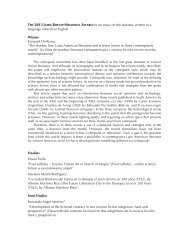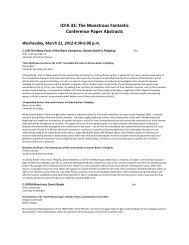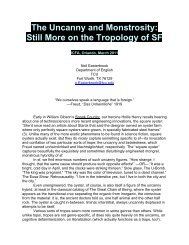stable in the bodies of these old hags. <strong>The</strong>y combine a senile, decaying and deformed flesh with the flesh of new life, conceived but as yetunformed. Life is shown in its two-fold contradictory process; it is the epitome of incompleteness. And such is precisely the grotesque conceptof the body (Rabelais and his World, 25-6). This putatively grotesque concept interfaces with the antagonism often vented towards olderwomen who wish to become mothers, which in Marge Piercy’s view “sounds just like the general hostility toward older women in our society,who are considered ugly and useless” (“Love and Sex in the Year 3000”, 2003, 134). While men often have children in their 50s, 60s and even70s, women’s reproductive years are much shorter, an aspect that is often perceived as not simply unfair, but as a distinct disadvantage when itcomes to career or other options. <strong>The</strong> scenario envisaged by Patchett provides an alternative, albeit "grotesque" and even, to some,"monstrous" vision of the Bakhtinian pregnant crone.Mothering Monsters: Technology, Reproduction, and the Maternal Body in Larissa Lai’s Salt Fish Girl and Nalo Hopkinson’s Midnight RobberKathryn AllanIndependent ScholarLarissa Lai’s Salt Fish Girl (2002) and Nalo Hopkinson’s Midnight Robber (2000) explore the ways that reproductive technologies have thecapacity to reshape human being in unexpected and frightening ways. Drawing on corporeal feminism (of Margrit Shildrick and Elizabeth Grosz,most notably), I interrogate the ways in which Lai and Hopkinson explore issues of monstrosity, maternity, and reproduction in posthumanworlds. Cloning meets reincarnation in Salt Fish Girl, as Lai traces the journey of durian-odoured Miranda from adolescence to motherhood. Iexamine the ways reproductive technologies, like cloning, intersect with environmental pollution and hybrid diseases to create a threateningmaternal body that has no need for men. Lai reflects that “now we step out of moist earth, out of DNA new and old, an imprint of what hasgone before, but also a variation. [...] By our strangeness we write our bodies into the future” (SFG, 259). Miranda’s struggles with corporealindeterminacy and “seepage” are reflected, I argue, in Midnight Robber’s Tan-Tan. Like Lai, Hopkinson exposes the particular vulnerability andmonstrosity inherent in maternity as Tan-Tan struggles with self-actualization and non-normative embodiment. Straddling the worlds oftechnology (Toussaint) and unadulterated nature (New Half-Way Tree), Tan-Tan becomes a contested site of the posthuman mother – her childis directly connected to the Grande Anansi Nanotech Interface: “[His] little bodystring will sing to Nanny tune, doux-doux. [He] will be a weavein she flesh” (MR, 328). Reading these two texts as exemplars of feminist post-cyberpunk SF, I ultimately propose that Lai and Hopkinsonsituate the monstrous maternal body as both vulnerable and technologically adaptable. Salt Fish Girl and Midnight Robber articulate thedangers inherent in adopting any new technology, but remain optimistic that the maternal body will continue to replicate on its own terms andin unforeseen ways.<strong>The</strong> Nuclear Family: <strong>Monstrous</strong> Domesticity in American Cold War Science FictionElizabeth LundbergUniversity of IowaThis paper investigates early cold war fears and anxieties surrounding domesticity, reproduction, and the female body as they play out inAmerican science fiction. My argument tracks several overlapping tensions: in the late 1940s and 1950s, at the same that there was a push inAmerican culture toward domesticity and family life, there also emerged fears of birth defects due to radiation exposure, and paranoia that anymember of one’s family could turn out to secretly be someone completely alien (a communist, a spy, homosexual, etc.). <strong>The</strong> American familywas seen as a tool for patriotism and containment but a tool that was constantly failing and betraying its nationalistic possibilities. <strong>The</strong>American woman’s body became a focal point for many of these fears and was coded monstrous, unpredictable, and abject, in need of controland regulation. <strong>The</strong> baby boom began in 1945, but women’s reproductive choices were more and more rigidly controlled: abortion wasregulated and prosecuted in the United States more than ever before starting in the 1940s, and the natural childbirth movement began inearnest in the 1940s as a reaction against the increasing medicalization of pregnancy and birth. Simultaneously, the Soviet Union was feminizedin some of its American portrayals, depicted as a wayward woman in need of courting, domestication, and impregnation, adding anotherpolitical dimension to some of the era’s portrayals of female and feminized monsters and villains. American domestic or “housewife heroine”science fiction of the late 1940s and 1950s, by authors such as Judith Merril, Kit Reed, Alice Eleanor Jones, and Wilmar H. Shiras, registered andoften literalized cold war anxieties surrounding domesticity and reproduction. This paper examines such texts for what they reveal aboutcultural pressures on the American cold war family.55. (SF) Sex, Power, and Language in Samuel Delany and Ursula K. Le Guin OakChair: Adam GuzkowskiTrent University<strong>Monstrous</strong> Love Affairs and Grotesque Genders in Samuel Delany’s Science FictionPäivi VäätänenUniversity of HelsinkiMonsters “ask us to reevaluate our cultural assumptions about race, gender, sexuality, our perception of difference, our tolerance toward itsexpression,” notes Jeffrey J. Cohen (1996:20). This is especially true of Samuel Delany’s science fiction, where monsters and aliens neverconform to strictly policed identity categories or norms. In Delany’s sf, love – or sex – is often an integral part of really understanding the alien.<strong>The</strong> aim of this paper is to present a cross-section of grotesque love affairs with the alien and the monstrous in Samuel Delany’s science fiction,and demonstrate how his aliens promote tolerance toward difference. Cohen argues that monsters are frightful because of their ability tobreak down categories. <strong>The</strong>refore, “the monster threatens to destroy not just individual members of a society, but the very cultural apparatusthrough which individuality is constituted and allowed.” (Cohen 1996:12) Whether one sees that destruction as terrifying or desirable dependson one’s attitude towards the very cultural apparatus. This paper concludes that when it comes to Delany’s aliens, monstrosity is definitely inthe eye of the beholder.
Abuse of Power: An Evolutionary Response within the Fiction of Ursula K. Le GuinSandra LindowUniversity of Wisconsin - StoutThroughout her career, Ursula K. Le Guin has examined the nature of power and abuse. Central in many of her novels and short stories is aglaring abuse of power. More often than not this abuse is made possible by the political structure of the culture she has created. As in “<strong>The</strong>Ones Who Walk Away from Omelas” one part of a society is used, enslaved, or disenfranchised, supposedly to improve the lives of others.Frequently, Le Guin structures her work so that an abuse of power--monstrous human behavior--provides inciting action and works as aprimary organizational component of her dialectical thought experiments. For instance, <strong>The</strong> Dispossessed begins with a mob attempt to stoneShevek to death, and Tehanu begins with <strong>The</strong>rru, a child who has been raped, shoved into the fire and left for dead. More often than not, theformula involves an unempowered, perhaps young and inexperienced, or elderly and marginalized protagonist attempting to overcome ornegotiate abuses of power in order to achieve a goal. To do this, the character must transcend personal uncertainty by entering a period ofself-searching and darkness before the status quo can be challenged and the balance of power reset. Ultimately, Le Guin’s solution to abuse ofpower requires communitas: a united community spirit focused on community action for the common good. This paper looks at Le Guin’sevolving thought experiment on abuse. I begin with “An Die Musik” (1961), Le Guin’s first published short story which does not offer any clearsolution to abuse but personal acceptance; I then examine <strong>The</strong> Word for World is Forest (1972) and <strong>The</strong> Lathe of Heaven (1973) where Le Guincreates a formula for community response to abuse that continues in her work until the present day.Perverted Binaries: Language and Sexual Difference in Le Guin’s <strong>The</strong> Left Hand of DarknessDouglas R. FisherAuburn UniversityIn what is perhaps her most famous novel, <strong>The</strong> Left Hand of Darkness, Ursula Le Guin introduces the alien society of the planet Winter throughthe eyes of the Terran diplomat Genly Ai. Of the many cultural differences Genly navigates while on Winter, most prominent is the absence ofsexual differentiation among the inhabitants of the planet, which prompts the inhabitants of Winter to perceive the permanent sexualdifferentation of Terrans such as Genly as a “perversion.” A great deal of the criticism published to date on <strong>The</strong> Left Hand of Darkness focuseson the sociological and anthropological implications of Le Guin’s argument, paying particular attention to the fluidity of gender and theperformance of sexuality. However, relatively little has been written on the problem of language in the novel. <strong>The</strong> major barrier both Genlyand the inhabitants of Winter overcome in the novel is the problem of a language which does not admit easy description of the others’ sexualrealities. In order to better understand the nature of the problem of language, and Le Guin’s implicit solution, in this paper I draw onWittgenstein’s early theory of language as a function relating elements from the set of experience to the set of symbols.56. (F/CYA) Death, Decay, and Depictions of the <strong>Monstrous</strong> MapleChair: Merja PolvinenUniversity of Helsinki<strong>The</strong> Secret Garden at the Back of the North Wind: <strong>The</strong> Life and Death Journey in Frances Hodgson Burnett and George MacDonaldJohn PenningtonSt. Norbert CollegeIn Secret Gardens Humphrey Carpenter writes that “George MacDonald’s influence seems to be present too” in Burnett’s Secret Garden, withMisselthwaite Manor echoing the gothic chambers in <strong>The</strong> Princess and the Goblin (1872) and the secret key to the garden reflecting the lockand key instrumental in “<strong>The</strong> Golden Key” (1867). In fact, Carpenter claims that “Mrs. Burnett met MacDonald when he was on a lecture tourin the 1870s, and there is every likelihood that she knew his books.” Juliet Dusinberre, in Alice to the Lighthouse, argues that Burnett, in <strong>The</strong>Secret Garden, moved away from the “prolonged meditation of the dead child” depicted in the novel In the Closed Room (1904) to a newoutlook: “<strong>The</strong> lugubrious Victorian death story has been transformed into a child’s celebration of living.” This transformation, Dusinberrecontends, was influenced by Burnett’s reading of two central texts: Gaskell’s North and South (1885) and Molesworth’s An Enchanted Garden(1892). I would offer a third, one that may be even more influential, one that may have convinced Burnett that death is another form of living,worth celebrating. That text is MacDonald’s At the Back of the North Wind. My essay will explore the life-death journey of MacDonald’s At theBack of the North Wind and connect to the death-life journey of Burnett’s Secret Garden. In the Garden (1925) Burnett has a favorite refrainthat encapsulates her desire to capture life in her novel about Mary, Colin, and Dickon: “As long as one has a garden one has a future; and aslong as one has a future one is alive.” My contention is that Burnett has worked through the loss of her son, Lionel, to view his death as a formof continued life symbolized by the garden. <strong>The</strong> Secret Garden moves from death to life as we witness the physical growth not only of thegarden but of Colin, who, rejoices: “I shall live forever and ever and ever! . . . I shall find out thousands and thousands of things. I shall find outabout people and creatures and everything that grows . . . I shall never stop making Magic!” For MacDonald, this Magic may be found in therealm at the back of the north wind, a realm that is everlasting—it is the realm of death that offers, magically, more life. MacDonald’s journeyin North Wind is a spiritual one and provides for Burnett the space to embrace, somewhat paradoxically, death as life. A central text I willexamine is “A Far, Fair Country,” an unpublished story by Burnett that grappled with the death of her son. Burnett writes: “<strong>The</strong>y think I died,”he cried. “<strong>The</strong>y think so—and it is all over—and I have awakened here.” Compare this to the end of North Wind: “I walked up the winding stair,and entered his room. A lovely figure, as white and almost as clear as alabaster, was lying on the bed. I saw at once how it was. <strong>The</strong>y thoughthe was dead. I knew that he had gone to the back of the north wind.” Furthermore, my essay will explore the importance of the fantasyimpulse in MacDonald’s and Burnett’s exploration of death: fantasy provides the liminal space whereby death can be exposed and explored. Atthe Back of the North Wind flaunts its two-worldness (the realm of London and the realm at the back of the north wind) in a hybrid fairy-talefantasy and realistic novel. <strong>The</strong> Secret Garden, while ostensibly realistic, needs the fantasy impulse to propel its narrative of death, while therealistic impulse backs away from death to lead to healing and renewal.
- Page 4 and 5: 5. (F) Wondrous Bodies of the Gende
- Page 6 and 7: Fantastic Suicide: Reading the Unca
- Page 8: Viral Posthumanism: Boundaries and
- Page 11 and 12: The Concept of Soul Divisibility in
- Page 13 and 14: Thursday, March 22, 2012 10:30 a.m.
- Page 15 and 16: 21. (CYA) Terrifying Futures: Post-
- Page 17 and 18: 23. (FTV/H) Now I’m Feelin’ Zom
- Page 19 and 20: Fight Club: Amalgam of the Horrific
- Page 21 and 22: Taking the Monsters out of the Clos
- Page 23 and 24: Kaspar J. SaxenaIndependent Scholar
- Page 25 and 26: 44. (CYA) The Monstrosity of Teenag
- Page 27 and 28: 46. (FTV/SF) Monstrous Spin-offs: T
- Page 29 and 30: 49. (F) Aspects of Miéville Captiv
- Page 31: 53. (SF) War and Crisis in 1940s an
- Page 35 and 36: Disappearing Natives: The Colonized
- Page 37 and 38: 60. (H/IF) Ancient and Medieval Mon
- Page 39 and 40: 62. (F) The Works of Tolkien Captiv
- Page 41 and 42: 67. (SF) Imperial and Postcolonial
- Page 43 and 44: Beheading the Gorgon: Beautifying C
- Page 45 and 46: 71. (VPA) Monstrous Music MagnoliaC
- Page 47 and 48: 73. (F/IF) Portraying New Worlds Ca
- Page 49 and 50: Friday, March 23, 2012 2:45-3:45 pm
- Page 51 and 52: 81. (FTV) Those Damn Dirty Apes! Cy
- Page 53 and 54: Friday, March 23, 2012 4:00-5:30 pm
- Page 55 and 56: 92. (F) Leaving the Demonized Other
- Page 57 and 58: 94. (FTV/CYA) Monstrosity and Devia
- Page 59 and 60: of cannibalism, ghostly seduction i
- Page 61 and 62: Saturday March 24, 2012 8:30-10:00
- Page 63 and 64: 104. (CYA) Classic Monsters, Reinte
- Page 65 and 66: 107. (VPA) Monstrous Gaming Bodies
- Page 67 and 68: who challenge the order that the Br
- Page 69 and 70: Reading Between the Times: A Critic
- Page 71 and 72: 117. (FTV) Monsters and Superheroes
- Page 73 and 74: 119. (IF/H/PCS) International Mash-
- Page 75 and 76: Focusing on Stoker's Dracula as one
- Page 77 and 78: Florida Atlantic UniversitySheri S.
- Page 79 and 80: Simmons CollegeIn the spate of rece
- Page 81 and 82: Independent ScholarKing’s story
- Page 83 and 84:
modernity opens up for every indivi
- Page 85 and 86:
Saturday March 24, 2012 4:00-5:30 p
- Page 87 and 88:
141. (FTV) Monstrous Masculinity Cy
- Page 89 and 90:
ultimately make peace with her mons
- Page 91 and 92:
where the almost-human sentient zom





